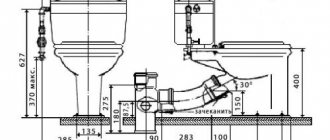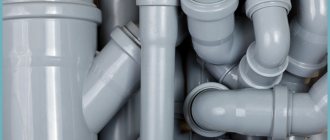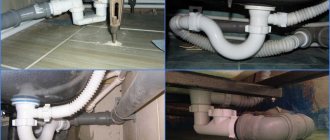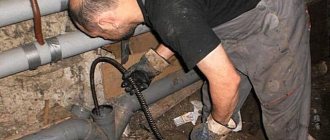The main reasons for the formation of leaks
Leaks at pipe joints can occur for several reasons. It's not always the plumber's fault. Before you start repairs, you need to find out what exactly happened, otherwise the work will be ineffective.
Sometimes a leak occurs not in the seam, but in the pipes themselves. This may occur due to a manufacturing defect, such as a microcrack or local heterogeneity of the material. Careless operation, mechanical damage, grounding connections from household appliances to cast iron pipes - all this can lead to failure. A minor crack can be fixed with a clamp or special insulating films. For large defects, the entire section will need to be replaced.
Pipe depressurization
At the junction, a leak may occur due to a mismatch in the diameters of the parts or an incorrect joint (misalignment, incorrect choice of installation method). Sometimes the plumber is also to blame: by connecting pipes without a safety margin, he gets a visible effect. But after a while, the seam begins to leak and the leak grows.
In old pipelines, holes can appear due to natural wear and tear: the cuffs cake, cast iron pipes are susceptible to corrosion, and plastic pipes are scratched inside, becoming brittle.
What to do in such a situation
1. Deepen the thinning area of the pipe somewhat, degrease and dry.
2. Seal this area with sealant.
3. To prevent a similar problem in the future, insulate the exhaust part of the riser.
If the smell still penetrates the apartment, then you will have to resort to more radical methods:
1. Cover the gap with “cold welding”. This is a two-component adhesive that can be easily sanded after hardening. You can improve the riser quite nicely.
2. Soak gauze with epoxy resin and wrap the pipe.
3. Wrap the riser with a rubber bandage and tie it with wire.
4. Apply the patch and secure with a clamp.
If a section of the sewer riser on the lower floors is damaged, then consultation with a specialist will be required. Perhaps one repair will not be enough. More radical methods will be required to eliminate the defect on the pipe. It must be taken into account that in this part of the sewer riser the pressure is the strongest.
Who is to blame for a leaking sewer pipe?
We have repeatedly touched upon issues related to the plumbing infrastructure of an apartment building. In particular, they told who owned the pipes and who paid for their maintenance.
But the topic does not lose its relevance - more and more new questions are being received: “The following situation has arisen: the sewer pipe in the whole house is rotten and leaking, as a result it drowns us and the neighbors below, whose apartment is insured... they are threatening to sue us. Are we the culprits of this incident, if, as far as I know, this riser is public property, or is housing and communal services still to blame? And am I obliged to change the riser at my own expense, or should housing and communal services pay for it?”
Let's sort it out in order.
Is a sewer riser considered common property?
The concept of common property of an apartment building is given in Article 36 of the Housing Code of the Russian Federation, as well as in the Rules for the maintenance of common property, approved by Decree of the Government of the Russian Federation No. 491 of August 13, 2006. Paragraph 5 of these Rules states that hot and cold water supply risers are part of the common property. What about sewerage? Last year, in accordance with the Decree of the Government of the Russian Federation No. 354 of May 6, paragraph 5 of the Rules was supplemented with the following provision: “The composition of the common property includes an in-house engineering drainage system, consisting of sewer outlets, fittings (including bends, transitions, branch pipes, revisions, crosses, tees), risers, plugs, exhaust pipes, drainage funnels, cleanings, branches from risers to the first butt joints, as well as other equipment located in this system.” Thus, sewer risers are now also classified as common property.
Who should replace the sewer riser?
Since the sewer riser is a common property, its maintenance and repair should be carried out by the utility organization servicing the house. We described in detail how to achieve a pipe replacement. In this case, the principle of action is the same. Replacing a rotten riser should fall on the shoulders of the housing and communal services organization.
Who is to blame: the owner or the utilities?
If an apartment is flooded, an application is made to the management company, and in emergency cases, to the emergency service. Representatives of these organizations, in the presence of all interested parties and witnesses, draw up a corresponding act. This document indicates in which apartments the flood occurred, for what reason, what property was damaged, etc. The act of leakage is very important, since it actually states who is guilty. So, if it is indicated that the flooding occurred due to rotting riser, the utility companies are to blame. After all, monitoring the wear and tear of plumbing equipment is their direct responsibility. If it is established that the residents of the apartment, for example, made an unauthorized replacement of equipment or caused any mechanical damage, the fault remains with the owner. In this case, we are talking about an insured apartment. Neighbors who insure their property against flooding should contact the insurance company. They, in turn, will issue an invoice for compensation for damage caused by the insured event to the guilty party.
Can they sue?
Yes. Neighbors have the right to go to court to demand compensation for property damage. However, if, as in this case, we are talking about the common property and guilt of the utility organization, you should not be afraid of this. It is necessary to involve utility companies as co-defendants and prove during the trial that the leak and, as a result, the damage occurred through their fault.
Types of common types of sealants, their properties, rules of use, pros and cons
In order to make quality repairs and not return to them for as long as possible, you need to choose the optimal method for sealing the seam in the sewer. Each type of sealing material has its own scope of use. In addition, the operating conditions of the system and the economic feasibility of using a particular option should be taken into account.
Types of common sealants
Metal polymers
Metal polymers are an innovative technology for pipe repair. It is also suitable for high pressure pipelines. Sewage systems operate by gravity, without pressure. Therefore, the use of metal polymers is generally not economically feasible. However, in critical areas, in systems operating at the limit of design capacity, the use of this method is justified. In this way you can seal the joint of any sewer pipe.
Use of metal polymer
To seal the seam, you need to dry it, clean some area around it, and degrease it. The metal polymer is applied in a thin layer to the entire surface of the joint. On top is a reinforcing component, for example a fiberglass mesh tape. Then a finishing, securing layer of material is applied. To quickly harden, the seam can be heated (if the pipe material allows it).
A sanitary toilet joint insulated using this method will last for centuries. In fact, the seam is put into a permanent capsule made of modern, corrosion- and wear-resistant material.
Cold welding
Cold welding is intended for sealing defects in metal parts or if a sewer pipe has burst. It is not suitable for plastic pipes.
Cold welding is a one- or two-component polymer paste. The consistency is liquid and dense, like plasticine. There are also differences in operating temperature. Because sewer pipes function under normal conditions, cold welding can be chosen at low temperatures, its characteristics are sufficient for the presented task.
Sealing cracks using cold welding
There are compounds that can work in water. In situations where it is not possible to shut off the drain, such welding can be a temporary salvation.
If the work is carried out correctly, the welded joint will be even stronger than the main pipeline materials.
First, the pipes must be completely stripped down to metal, degreased, and dried. To obtain a strong and visually neat connection, experienced craftsmen use liquid compounds. Having thoroughly soaked a piece of cloth with it, tightly wrap the problematic seam. During deformation, the composition begins to “work”, harden, “welding” the parts.
The cost of such repairs is minimal. However, according to reviews from experts and users, this is only a temporary measure that allows the continuation of operation of the sewer system until a more complete or major overhaul.
Ribbon
Sanitary tape will help seal the sewer pipe in the toilet.
It is a multilayer elastic material. It comes in two versions: with and without decorative coating. In any case, the main layer is a bitumen-polymer composition, which is absolutely waterproof and ensures the performance of the tape. At the bottom of this sealant is an adhesive base. The decorative surface additionally protects the tape from negative environmental influences: UV and temperature changes.
Pipe tape
Sanitary tapes have a number of advantages:
- low cost;
- ease of installation;
- reliability and durability;
- ability to work with different types of pipes;
- the tape does not conduct electricity, therefore it is able to protect metal structures from corrosion;
- resistance to environmental influences (with a protective coating).
Tape marked L is for summer and does not lose its characteristics when working at temperatures up to +300 degrees. Winter (marked “Z”) operates in the range of -200...+100 degrees. It is clear that the pipeline will not fall into such conditions in any case. However, when repairing joints outdoors, it is better to play it safe and use winter tape.
Installation of the tape is carried out on a cleaned, degreased area. A well-glued tape is guaranteed to last up to 30 years. The sealant should be wound evenly, avoiding the appearance of bubbles and wrinkles, slightly tighter. In this case, the geometry of the actions is in a spiral, overlapping the previous layer by half its thickness. Thus, at each point of the treated surface there will be two standing sealants. If the tape does not have a decorative coating, the finished connection can be painted with a protective material.
Based on silicone rubber
Sealants based on silicone rubber are favorites when carrying out a wide range of installation work, including plumbing. This is a combined composition that has all the benefits of each component.
Rubber sealants have high viscosity and very good adhesion, which allows you to firmly seal the resulting hole.
Silicone sealant
Therefore, they are not so sensitive to the degree of cleaning of the treated area. With high strength, the seam is very elastic. This sealant, like others, has electrical insulating properties, but unlike analogues, it is not sensitive to external influences, so it can be used on plastic communications. Temperature changes over a wide range, high humidity, wind, and exposure to UV rays are not dangerous for a joint sealed with rubber.
Heeled
Kabolka, despite the fact that it is a rather primitive type of sealant, is very popular and is actively used both at home and in professional work. This is a tow or rope, usually made of natural fiber, impregnated with special solutions. To close a crack in the bathroom, the heel is generously impregnated with bitumen resins. This makes its fibers resistant to rotting and drying out, and the pipe connection, covered with a heel, is not subject to corrosion.
Pipe socket
Even a beginner without special knowledge can work with this material: only accuracy and a little effort are required. The price is low and the reliability is good. During installation, it is not necessary to clean and degrease the working area to the same extent as when working with synthetic sealants. That's why heels are so popular.
Technical sulfur
Technical sulfur is sold in lumps or in powder form. It's inexpensive. To work with sulfur as an insulating material, it must be heated to the melting point (130-150 degrees). The substance will turn into liquid resin, which should be used to lubricate the joint of sewer pipes.
To install a pipeline using sulfur, additional equipment is required: containers and heating means. You also need to know how to use it. Another drawback is that in its already frozen form, sulfur is quite fragile, the seam is not elastic.
Thick fabric
A piece of dense fabric can be used as an ambulance for emergency sewer repairs. It must be impregnated with resin or other waterproofing solution and used as a clamp. A harness made of such fabric can replace a sealing gasket.
This repair method can only be used as an emergency when it is not possible to use more reliable and durable materials. The fabric is not resistant to external influences and wears out quickly.
How to fix leaks in plastic sewer pipes
With PVC pipes, everything is quite simple: it is enough to accurately localize the problem, and its further solution will immediately appear on the surface.
There are two areas where a sewer pipe typically leaks in a toilet or other area:
- A single section of pipeline
. If a section of a plastic pipe is damaged, the best solution is to replace this section. Practice shows that the implementation of this method will give much better results than tightening the pipe with various clamps and gaskets. In addition, such pipe repairs are carried out extremely quickly, and the cost of the work is low. - Pipeline joint
. If a sewer pipe is leaking at the junction, then the cause of the leak in this case is usually damage or displacement of the gasket, and it must, accordingly, be replaced or put in its place, which will require disconnecting the pipes. That is, in this case, sealing the system is required (read: “Sealant for sewer pipes - what and how best to seal it”). If the socket itself is damaged, causing the sewer pipe joint to leak, then the sewer leak can be eliminated by replacing this section of pipe.
Plastic sewer pipes have a lot of positive qualities. For installation, such products are ideal because they are quite lightweight and can be installed without problems. In addition, when installing plastic pipes, you can use sections of different lengths, since couplings allow you to connect them completely unhindered. If a sewer riser made of plastic leaks, repairs are quite easy.
The main stages of eliminating sewer pipe leaks and rules for their elimination
Whatever material is used for sewer repair, the general algorithm of actions will be approximately the same.
- The first step is to clearly determine the location of the leak. The location of the breakdown is better visible as long as the sewer is not blocked. Then you can visually determine where the contents of the pipes are flowing from: a crack or hole in the pipe, or at the junction of the pipes.
- Then you should shut off the sewer.
- The damaged area must be dried. Many sealants are sensitive to the degree of cleaning and humidity of the application site.
- Then the working surface is cleaned (from dirt, layers of old paint, etc.) and degreased.
- Next, the actual repair work is carried out.
- Any insulating materials must dry for the time specified in their user instructions. It is imperative to check the tightness of the connection; only after this can the area being repaired be connected to the sewer.
Fixing a leak
If all stages are completed efficiently, you will be able to use your communications for a long time.
Cracks and holes
Cracks in a plastic pipe can be sealed with a piece of plastic cut from a similar pipe. Any glue that can be used to glue PVC or polypropylene parts is suitable for this.
A hole in a cast iron pipe is repaired with a piece of rubber and a metal clamp.
If the damage is serious, you can apply a rubber bandage to the pipe section, securing it with a clamp or wire.
Rubber and a homemade or purchased clamp can solve the problem
Thus, now you know almost all the causes of pipe leaks and several ways to eliminate them.
Recommendations for repairing sewer systems made of plastic and cast iron
When repairing a plastic sewer system, it is important to correctly localize the breakdown and choose the optimal material for repair. Most often this involves repairing cracks or holes in the pipes themselves using some kind of sealant. The second option is to repair pipe joints. Typically, replacement of gaskets, connection and sealing of the seam is required. No special equipment required.
If cast iron pipes break, professional help may be required. Finding a leak is more difficult, since the pipes may be rusty and constantly covered with condensation. It is recommended to cool the air in the room to 15 degrees before starting work to minimize fogging of the pipes. The choice of repair method should also be based on experience and skill. If possible, a rational solution would be to replace cast iron pipes with plastic ones. Large-scale, but one-time expenses will be worth it for years of trouble-free operation.
The most difficult repair option is connecting pipes from different materials. To install such a joint, it is recommended to use special adapters that provide good protection of the seam from leaks.
Causes and locations of leaks
All defects that can cause unpleasant situations can be divided into several categories.
Pipe corrosion
Corrosive effects. This option applies more to cast iron pipes. Constantly being in the environment of waste water with various chemical detergents, the metal wall becomes thinner, which can lead to its complete destruction. In addition, there is also an external influence. It is explained by the temperature difference. You may have noticed that water droplets accumulate on the pipe. This happens in cases where the temperature in the room is lower than that inside the pipe. Such formations lead to rust with subsequent failure of pipes. Another source of destructive influence may be the connected ground. Due to the flow of electric current, reactions occur that lead to a decrease in wall thickness. Although unlikely, ceramic pipes can be destroyed by hydrofluoric acid if someone decides to flush it down the drain.
Physical impact. All of the above products may be damaged in this way. Plastic and ceramic pipes are especially susceptible to it. Such situations arise during the installation process or during other repair work near the vent risers.
Manufacturing defects. Due to errors in the technological process, shells can form in the material, which are subsequently washed out and leak.
The main places where a fistula can form:
- at the junction;
- on a straight horizontal or vertical section.
Fistula on the straight section
If the first option occurs and it is possible to contact those who carried out the installation, then you can make a claim to them, because these are always the consequences of incorrect installation.
Preventive measures against sewerage breakdowns
In order for the sewer system in the house to last a long time and not cause problems, it must be used carefully, following certain rules:
- Do not flush sand, cement and other construction mixtures, as well as stones and construction waste down the drain.
- Aggressive chemical solutions can also damage pipes
- Any large objects can cause blockage and further damage.
- It is recommended to install grease traps in the kitchen. Another option to save the sewer from grease blockages is to rinse off the boiling water after the grease.
- Any crack, even the smallest one, must be repaired immediately, without waiting until the pipes burst.
- If possible, replace all problem areas: cast iron pipes with a lot of wear, previously “sealed” areas with new ones.
In everyday life, various unpleasant situations arise related to leaking sewer pipes. To eliminate them, many methods and materials are used. It is important to follow all recommendations and troubleshoot problems efficiently. Then the sewer pipes will not bother you for a long time.
Elimination
Let's look at several of the most common causes of leaks and select the most acceptable option for eliminating it for each of them. So, it's a blockage.
- If a blockage has formed in the sewer pipes located on the territory of your apartment, then eliminating it is quite easy. You will need a plumbing cable, with which you, after turning off the water, will clear the blockage. As a rule, the main element of a pipe plug is frozen fat. This is what you will soften with a cable. Then, when the water supply is restored, the pieces of fat will be safely washed down the drain.
- If you live on the first floor, and the blockage occurs somewhere in the basement, then everything will happen much worse. All sewage water from the upper floors will flow into the basement and, encountering a plug, return to your apartment. And here no sewer plugs will help. Dirty water will flow from the toilet, from the sink, and even from the bathroom.
In this case, all you can do is call the emergency service, and before they arrive, go down to the basement and open the riser inspection cover. The blockage, of course, won’t go anywhere, but sewage will stop flowing into your apartment.
Appearance of cast iron revision
Just be sure to leave the cover and its fasteners in a visible place so that emergency personnel will have no problem getting it back in place.
Can they sue?
Responsibility of apartment owners Please note that this situation only applies to the case of an insured apartment. Then, in the event of flooding, the owners of the insured apartment contact the insurance company. And the insurers, in turn, issue an invoice for compensation for the damage caused to the person responsible for the leak.
If there is flooding in the apartment due to a break, leak or any other defect in the sewer pipe, you should write an application for replacement of the riser to the housing office or management company to replace the riser. And if it’s an emergency, then go to the emergency service.
Fistula repair
Method one
Wrap the hole with gasket
Cover the rubber with a clamp and tighten it
Method two
For a large fistula you will need a repair coupling
Cut the rubber to fit the size of the coupling
Tighten the coupling - the leak is closed
There are different plugs for sewer pipes.
- Cleaning plug. If you do not use cleaning, you can cover the joint between the pipe and the wedge with sanitary silicone. To allow the joint to dry out, it is not recommended to use the sewer for 2 hours. You can dry it with a hairdryer. If the chopper allows water to pass through, you can pull it out, after slightly shaking it, and trim it to insert it more tightly. But before driving the chop in again, it is better to wrap it in plastic film from an ordinary bag.
Plastic plug - more reliable protection
- You can put a plastic plug instead of a wooden wedge, and put a rubber gasket on the plug. How to seal a sewer pipe if it leaks again? You need to seal the plug with the gasket with sanitary silicone.
- If there is a leak at the joint, you need to completely fill the joint, fill it all around over the sealing with gum arabic, that is, liquid glass - office silicate glue.
Repair of cast iron pipes
Although cast iron pipes, which were installed about 50 years ago in multi-story buildings throughout the Soviet Union, are already old and worn out, they continue to be used in many apartments. Today, cast iron pipes are not so often used when installing a sewer system, because there are more practical and cheaper PVC pipes.
Cast iron loses its properties over time as it is susceptible to corrosion. Cracks may appear on its surface, and you may encounter a broken sewer pipe. If it is not possible or there is an urgent need to replace elements of the sewer system, the pipe should be repaired.
- First, you should locate the leak and mark it with chalk.
- Then the insides of the sewer pipe must be freed of water.
- Now we begin to clean the surface of the pipe using sandpaper.
- We treat the surface with a degreasing agent.
- We repair the damaged area using “cold welding” glue, which we previously bought at a hardware store.
- We install a rubber seal on top, secure it with a special clamp.
Note! Cracks in a sewer pipe can be repaired using rubber and wire, fabric soaked in paint, and a sealing compound. The last option is used if cast iron pipes leak at the junction.
Perennial cast iron pipes in need of repair
Leaking Sewer Riser Who Should Repair
There is no strictly defined form for such an application, so it is drawn up in a free form.
The owners of the damaged apartment can file a lawsuit demanding compensation for property damage. If the culprit is the management company, then it is a co-defendant. And at the court hearing, it will be necessary to prove the guilt of the management company, that the leak occurred through their fault, and the consequence of this was damage to the plaintiff’s property.
At whose expense is the replacement carried out (read more...)
Who owns the sewer riser
Replacing a sewer riser in an apartment - at whose expense
Thus, all equipment maintenance and repair work in the apartment building, which the residents own on a shared basis, has already been paid for. An application to the housing office or management company obliges them to repair the sewer risers in the apartment without charging additional fees. At the same time, all attempts to force residents to pay for repairs will be illegal. An exception is when a sewer or any other pipe breaks due to the fault of the residents due to their willful actions.











